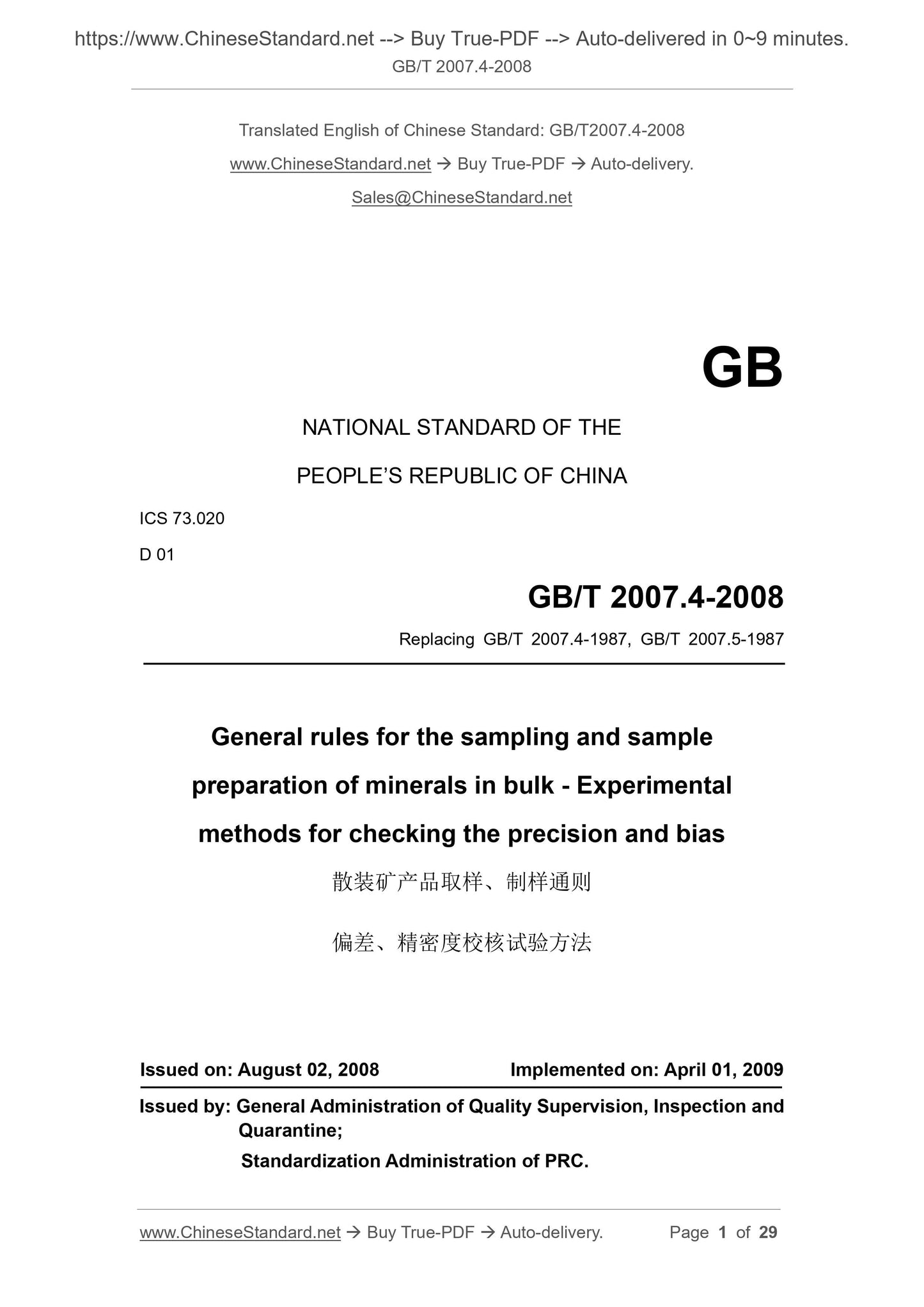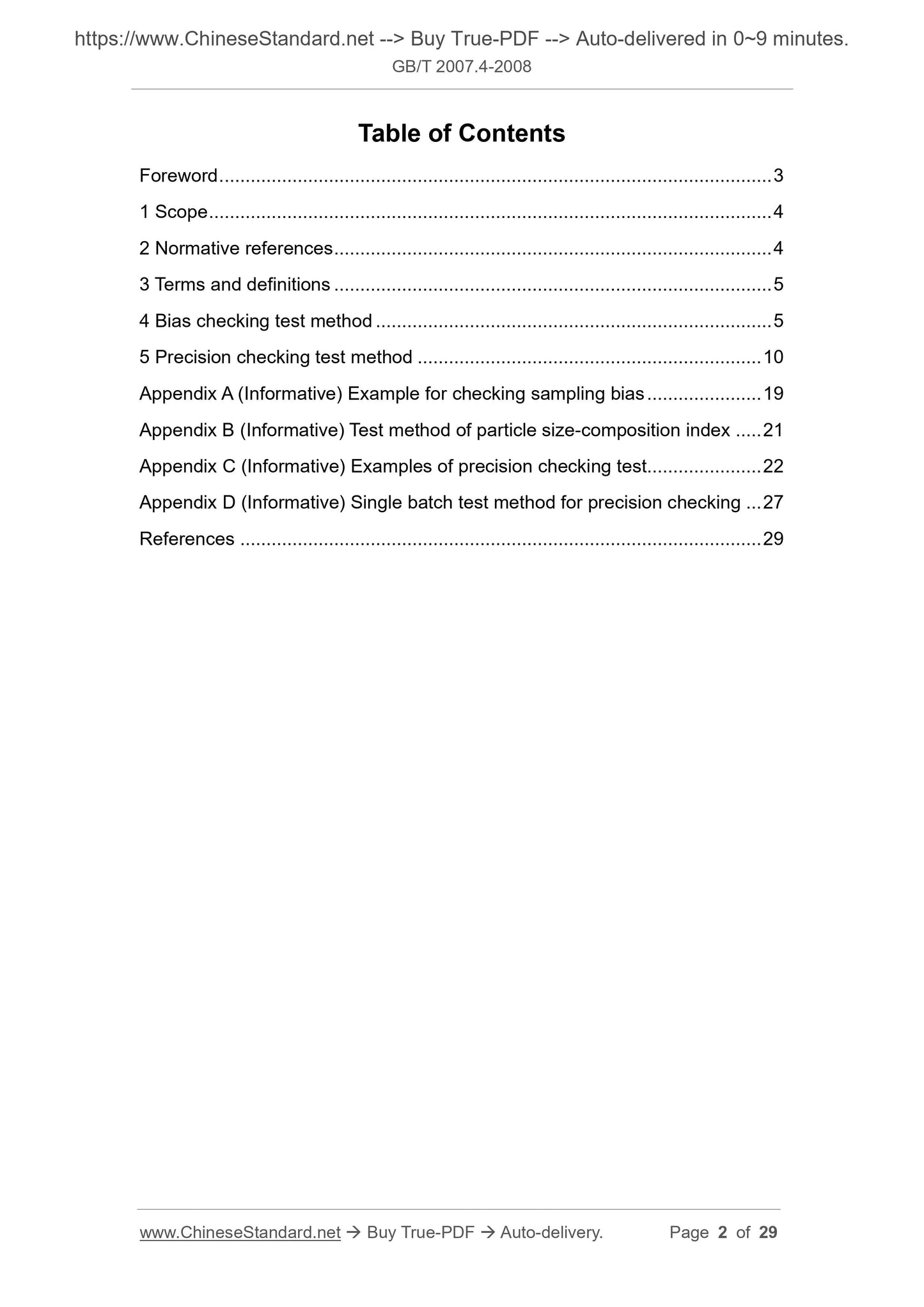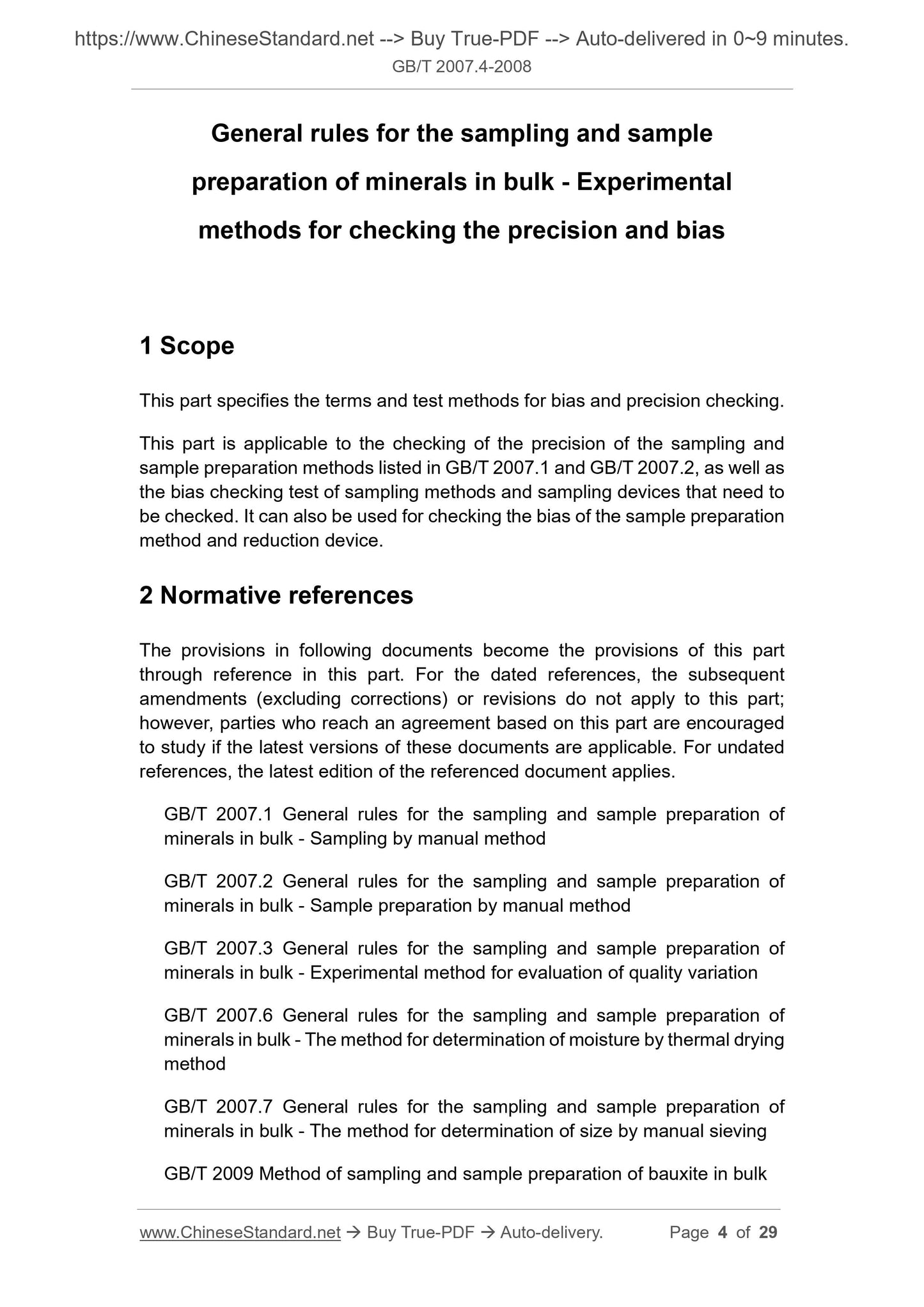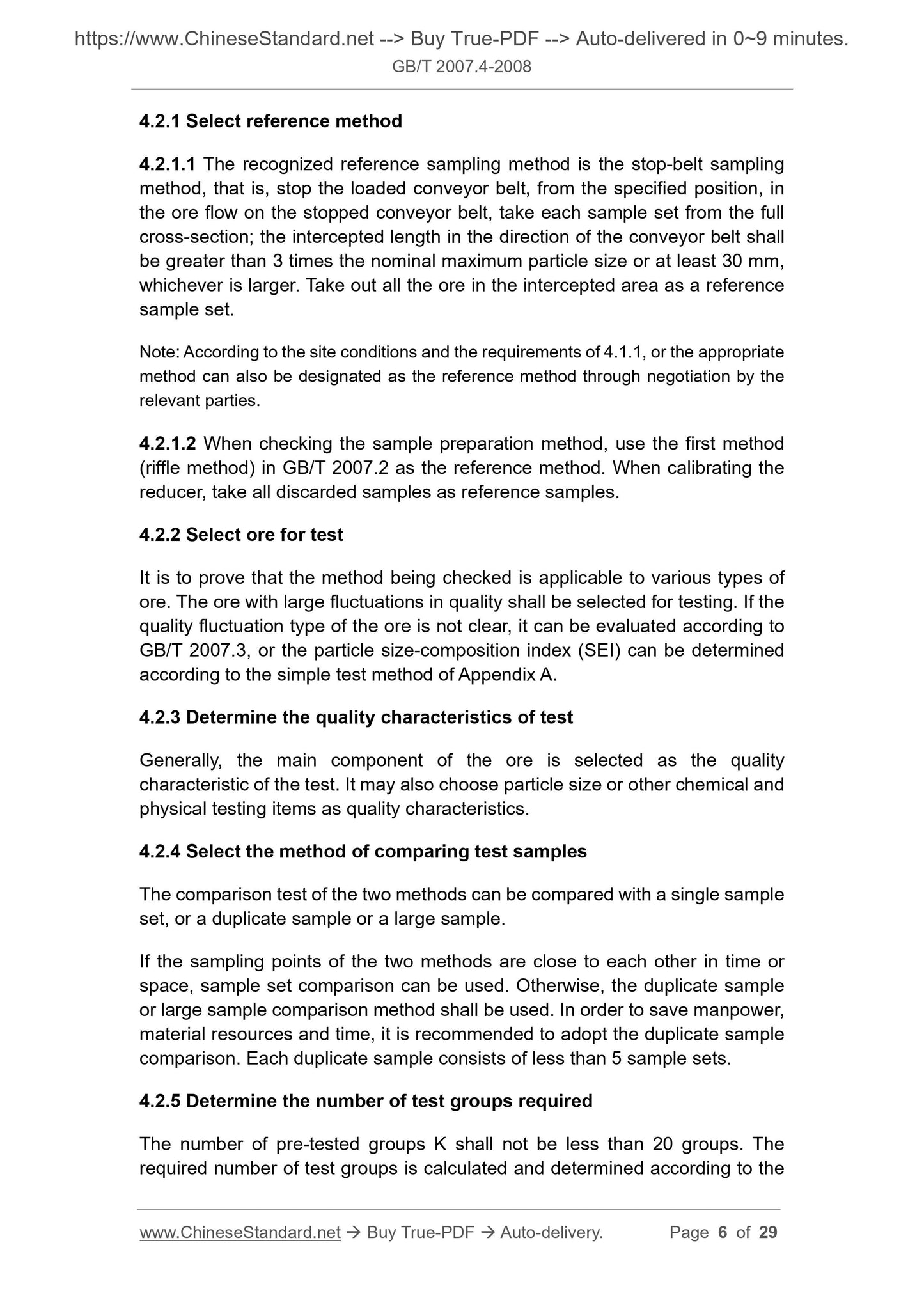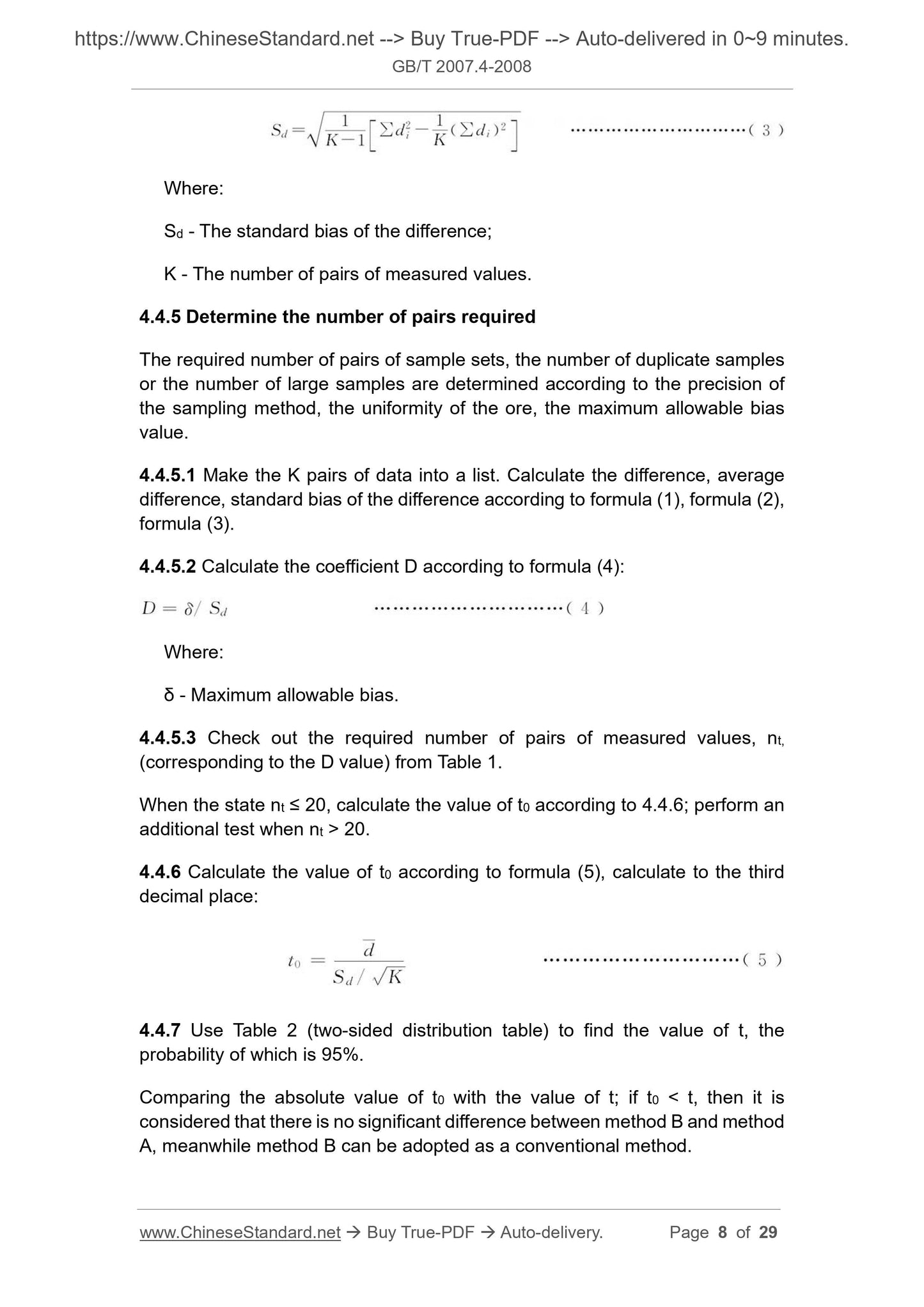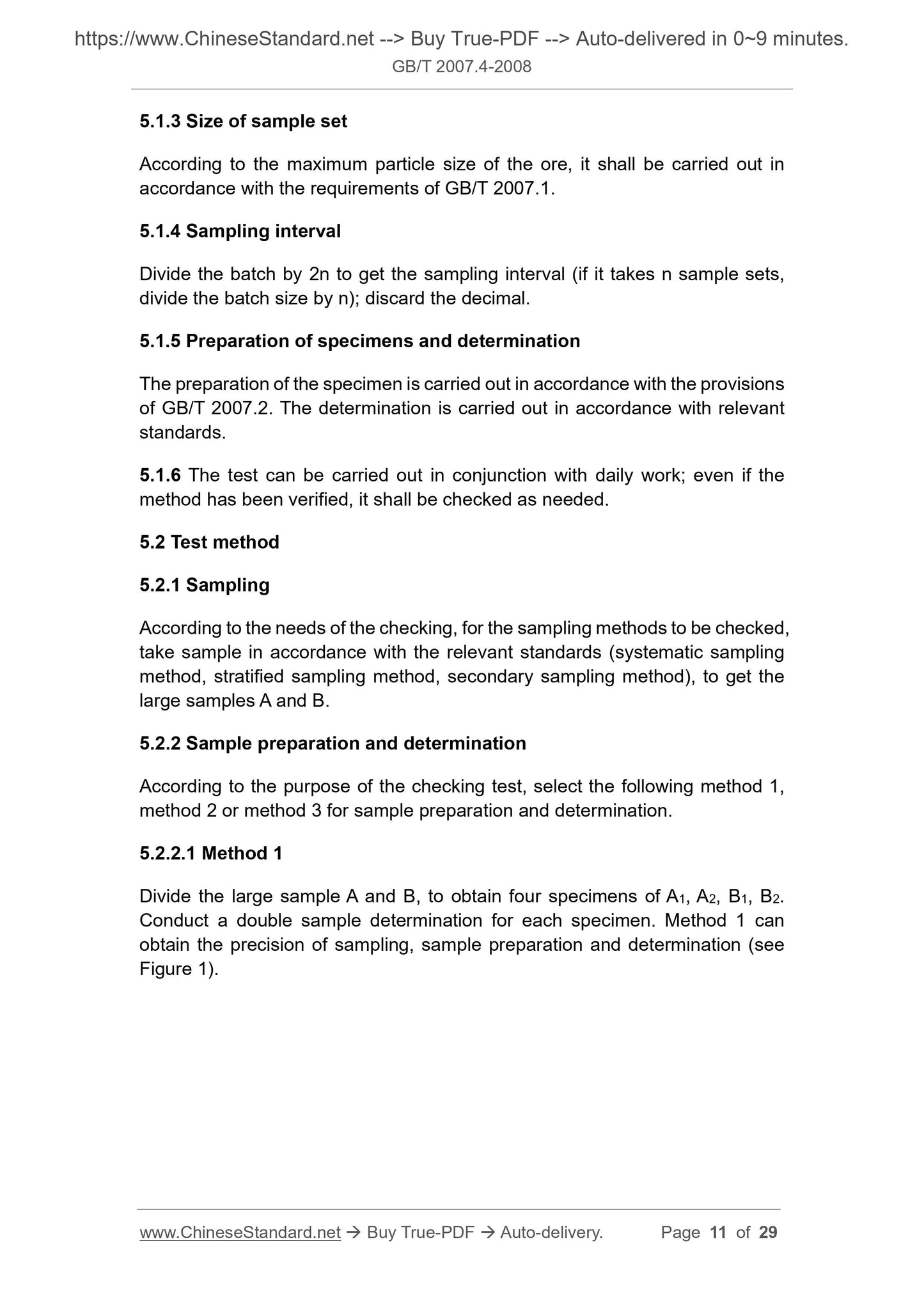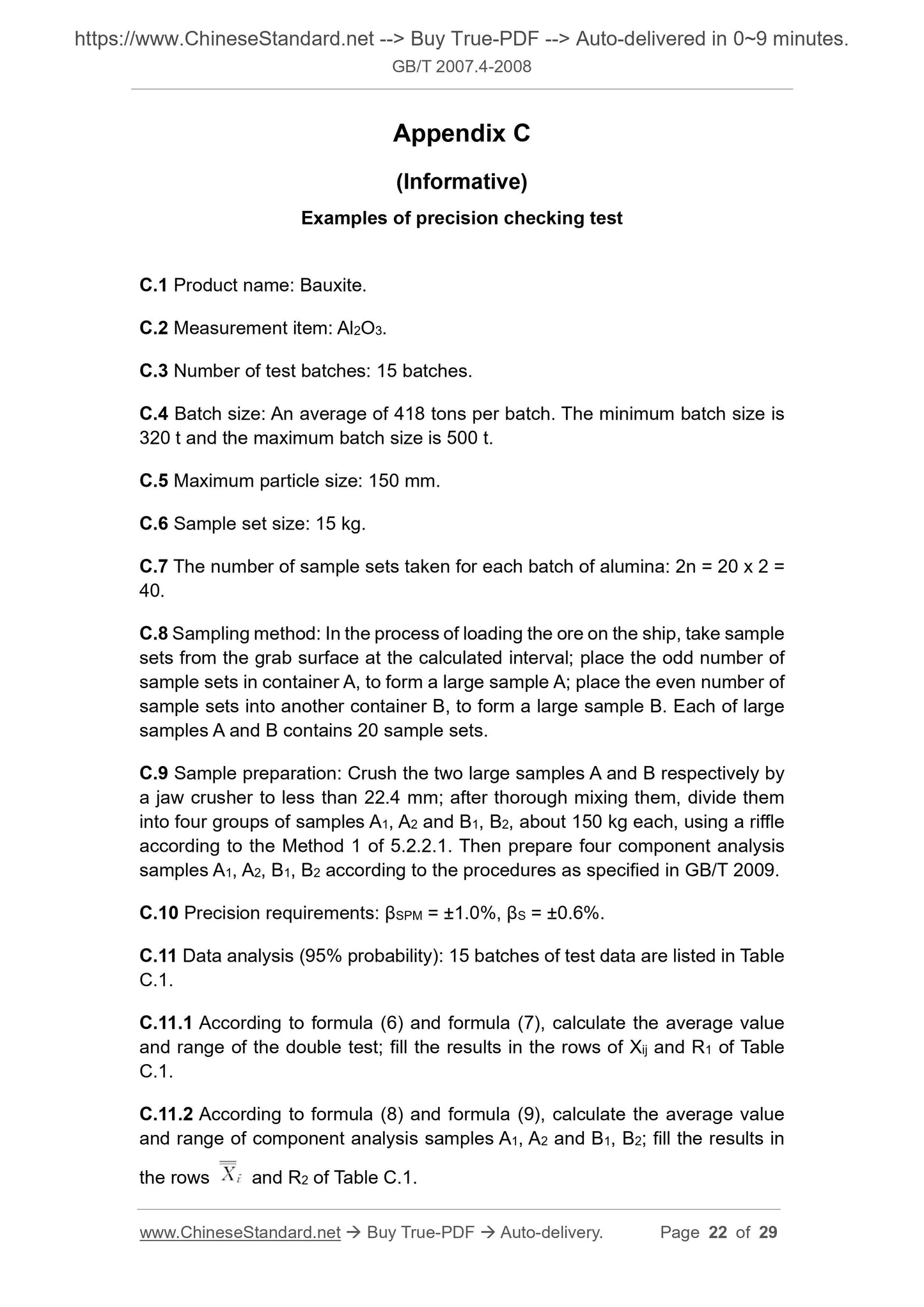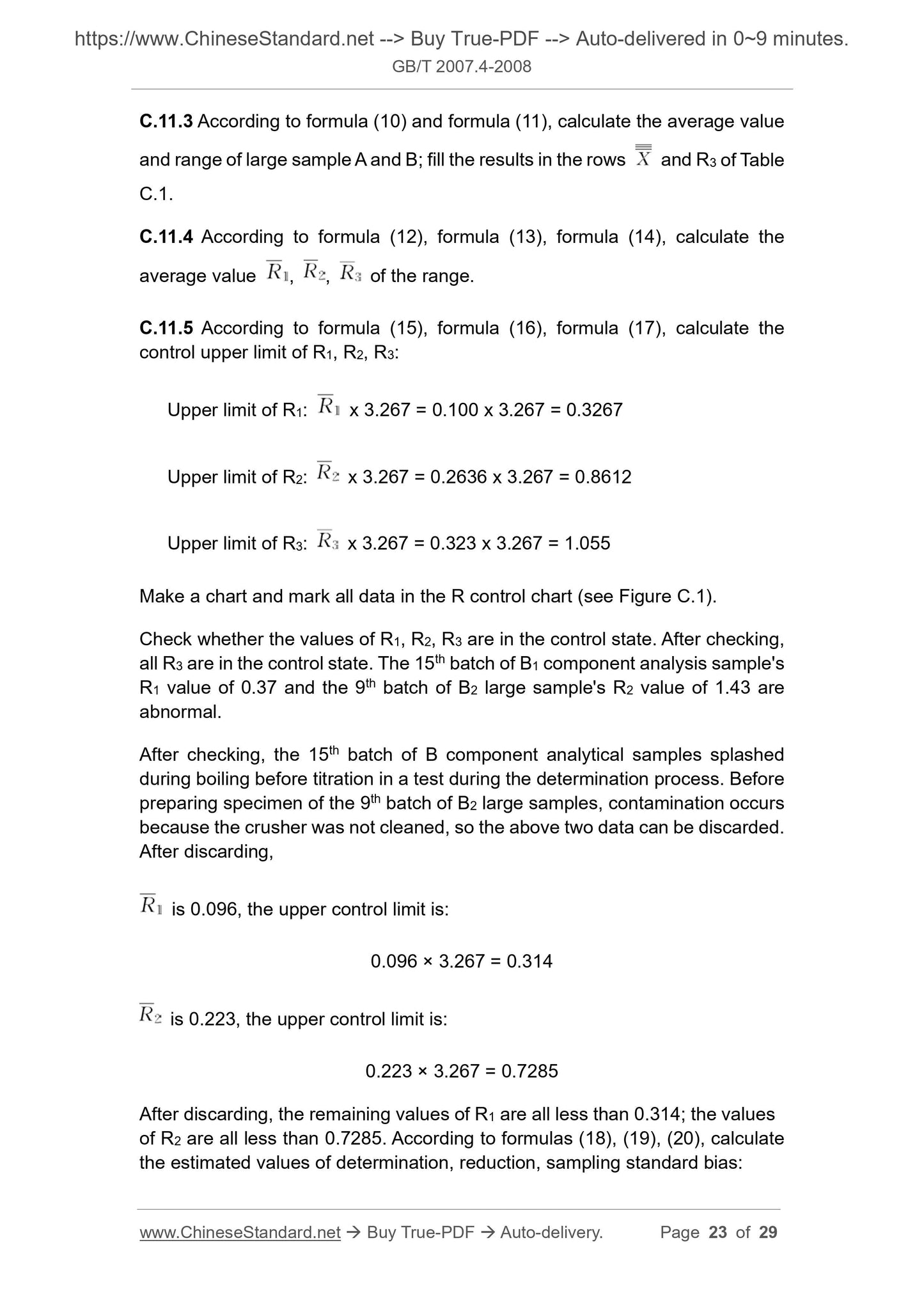1
/
of
8
www.ChineseStandard.us -- Field Test Asia Pte. Ltd.
GB/T 2007.4-2008 English PDF (GB/T2007.4-2008)
GB/T 2007.4-2008 English PDF (GB/T2007.4-2008)
Regular price
$350.00
Regular price
Sale price
$350.00
Unit price
/
per
Shipping calculated at checkout.
Couldn't load pickup availability
GB/T 2007.4-2008: General rules for the sampling and sample preparation of minerals in bulk - Experimental methods for checking the precision and bias
Delivery: 9 seconds. Download (& Email) true-PDF + Invoice.
Get Quotation: Click GB/T 2007.4-2008 (Self-service in 1-minute)
Historical versions (Master-website): GB/T 2007.4-2008
Preview True-PDF (Reload/Scroll-down if blank)
GB/T 2007.4-2008
GB
NATIONAL STANDARD OF THE
PEOPLE’S REPUBLIC OF CHINA
ICS 73.020
D 01
Replacing GB/T 2007.4-1987, GB/T 2007.5-1987
General rules for the sampling and sample
preparation of minerals in bulk - Experimental
methods for checking the precision and bias
ISSUED ON: AUGUST 02, 2008
IMPLEMENTED ON: APRIL 01, 2009
Issued by: General Administration of Quality Supervision, Inspection and
Quarantine;
Standardization Administration of PRC.
Table of Contents
Foreword ... 3
1 Scope ... 4
2 Normative references ... 4
3 Terms and definitions ... 5
4 Bias checking test method ... 5
5 Precision checking test method ... 10
Appendix A (Informative) Example for checking sampling bias ... 19
Appendix B (Informative) Test method of particle size-composition index ... 21
Appendix C (Informative) Examples of precision checking test... 22
Appendix D (Informative) Single batch test method for precision checking ... 27
References ... 29
General rules for the sampling and sample
preparation of minerals in bulk - Experimental
methods for checking the precision and bias
1 Scope
This part specifies the terms and test methods for bias and precision checking.
This part is applicable to the checking of the precision of the sampling and
sample preparation methods listed in GB/T 2007.1 and GB/T 2007.2, as well as
the bias checking test of sampling methods and sampling devices that need to
be checked. It can also be used for checking the bias of the sample preparation
method and reduction device.
2 Normative references
The provisions in following documents become the provisions of this part
through reference in this part. For the dated references, the subsequent
amendments (excluding corrections) or revisions do not apply to this part;
however, parties who reach an agreement based on this part are encouraged
to study if the latest versions of these documents are applicable. For undated
references, the latest edition of the referenced document applies.
GB/T 2007.1 General rules for the sampling and sample preparation of
minerals in bulk - Sampling by manual method
GB/T 2007.2 General rules for the sampling and sample preparation of
minerals in bulk - Sample preparation by manual method
GB/T 2007.3 General rules for the sampling and sample preparation of
minerals in bulk - Experimental method for evaluation of quality variation
GB/T 2007.6 General rules for the sampling and sample preparation of
minerals in bulk - The method for determination of moisture by thermal drying
method
GB/T 2007.7 General rules for the sampling and sample preparation of
minerals in bulk - The method for determination of size by manual sieving
GB/T 2009 Method of sampling and sample preparation of bauxite in bulk
4.2.1 Select reference method
4.2.1.1 The recognized reference sampling method is the stop-belt sampling
method, that is, stop the loaded conveyor belt, from the specified position, in
the ore flow on the stopped conveyor belt, take each sample set from the full
cross-section; the intercepted length in the direction of the conveyor belt shall
be greater than 3 times the nominal maximum particle size or at least 30 mm,
whichever is larger. Take out all the ore in the intercepted area as a reference
sample set.
Note: According to the site conditions and the requirements of 4.1.1, or the appropriate
method can also be designated as the reference method through negotiation by the
relevant parties.
4.2.1.2 When checking the sample preparation method, use the first method
(riffle method) in GB/T 2007.2 as the reference method. When calibrating the
reducer, take all discarded samples as reference samples.
4.2.2 Select ore for test
It is to prove that the method being checked is applicable to various types of
ore. The ore with large fluctuations in quality shall be selected for testing. If the
quality fluctuation type of the ore is not clear, it can be evaluated according to
GB/T 2007.3, or the particle size-composition index (SEI) can be determined
according to the simple test method of Appendix A.
4.2.3 Determine the quality characteristics of test
Generally, the main component of the ore is selected as the quality
characteristic of the test. It may also choose particle size or other chemical and
physical testing items as quality characteristics.
4.2.4 Select the method of comparing test samples
The comparison test of the two methods can be compared with a single sample
set, or a duplicate sample or a large sample.
If the sampling points of the two methods are close to each other in time or
space, sample set comparison can be used. Otherwise, the duplicate sample
or large sample comparison method shall be used. In order to save manpower,
material resources and time, it is recommended to adopt the duplicate sample
comparison. Each duplicate sample consists of less than 5 sample sets.
4.2.5 Determine the number of test groups required
The number of pre-tested groups K shall not be less than 20 groups. The
required number of test groups is calculated and determined according to the
Where:
Sd - The standard bias of the difference;
K - The number of pairs of measured values.
4.4.5 Determine the number of pairs required
The required number of pairs of sample sets, the number of duplicate samples
or the number of large samples are determined according to the precision of
the sampling method, the uniformity of the ore, the maximum allowable bias
value.
4.4.5.1 Make the K pairs of data into a list. Calculate the difference, average
difference, standard bias of the difference according to formula (1), formula (2),
formula (3).
4.4.5.2 Calculate the coefficient D according to formula (4):
Where:
δ - Maximum allowable bias.
4.4.5.3 Check out the required number of pairs of measured values, nt,
(corresponding to the D value) from Table 1.
When the state nt ≤ 20, calculate the value of t0 according to 4.4.6; perform an
additional test when nt > 20.
4.4.6 Calculate the value of t0 according to formula (5), calculate to the third
decimal place:
4.4.7 Use Table 2 (two-sided distribution table) to find the value of t, the
probability of which is 95%.
Comparing the absolute value of t0 with the value of t; if t0 < t, then it is
considered that there is no significant difference between method B and method
A, meanwhile method B can be adopted as a conventional method.
5.1.3 Size of sample set
According to the maximum particle size of the ore, it shall be carried out in
accordance with the requirements of GB/T 2007.1.
5.1.4 Sampling interval
Divide the batch by 2n to get the sampling interval (if it takes n sample sets,
divide the batch size by n); discard the decimal.
5.1.5 Preparation of specimens and determination
The preparation of the specimen is carried out in accordance with the provisions
of GB/T 2007.2. The determination is carried out in accordance with relevant
standards.
5.1.6 The test can be carried out in conjunction with daily work; even if the
method has been verified, it shall be checked as needed.
5.2 Test method
5.2.1 Sampling
According to the needs of the checking, for the sampling methods to be checked,
take sample in accordance with the relevant standards (systematic sampling
method, stratified sampling method, secondary sampling method), to get the
large samples A and B.
5.2.2 Sample preparation and determination
According to the purpose of the checking test, select the following method 1,
method 2 or method 3 for sample preparation and determination.
5.2.2.1 Method 1
Divide the large sample A and B, to obtain four specimens of A1, A2, B1, B2.
Conduct a double sample determination for each specimen. Method 1 can
obtain the precision of sampling, sample preparation and determination (see
Figure 1).
Appendix C
(Informative)
Examples of precision checking test
C.1 Product name: Bauxite.
C.2 Measurement item: Al2O3.
C.3 Number of test batches: 15 batches.
C.4 Batch size: An average of 418 tons per batch. The minimum batch size is
320 t and the maximum batch size is 500 t.
C.5 Maximum particle size: 150 mm.
C.6 Sample set size: 15 kg.
C.7 The number of sample sets taken for each batch of alumina: 2n = 20 x 2 =
40.
C.8 Sampling method: In the process of loading the ore on the ship, take sample
sets from the grab surface at the calculated interval; place the odd number of
sample sets in container A, to form a large sample A; place the even number of
sample sets into another container B, to form a large sample B. Each of large
samples A and B contains 20 sample sets.
C.9 Sample preparation: Crush the two large samples A and B respectively by
a jaw crusher to less than 22.4 mm; after thorough mixing them, divide them
into four groups of samples A1, A2 and B1, B2, about 150 kg each, using a riffle
according to the Method 1 of 5.2.2.1. Then prepare four component analysis
samples A1, A2, B1, B2 according to the procedures as specified in GB/T 2009.
C.10 Precision requirements: βSPM = ±1.0%, βS = ±0.6%.
C.11 Data analysis (95% probability): 15 batches of test data are listed in Table
C.1.
C.11.1 According to formula (6) and formula (7), calculate the average value
and range of the double test; fill the results in the rows of Xij and R1 of Table
C.1.
C.11.2 According to formula (8) and formula (9), calculate the average value
and range of component analysis samples A1, A2 and B1, B2; fill the results in
the rows and R2 of Table C.1.
C.11.3 According to formula (10) and formula (11), calculate the average value
and range of large sample A and B; fill the results in the rows and R3 of Table
C.1.
C.11.4 According to formula (12), formula (13), formula (14), calculate the
average value , , of the range.
C.11.5 According to formula (15), formula (16), formula (17), calculate the
control upper limit of R1, R2, R3:
Upper limit of R1: x 3.267 = 0.100 x 3.267 = 0.3267
Upper limit of R2: x 3.267 = 0.2636 x 3.267 = 0.8612
Upper limit of R3: x 3.267 = 0.323 x 3.267 = 1.055
Make a chart and mark all data in the R control chart (see Figure C.1).
Check whether the values of R1, R2, R3 are in the control state. After checking,
all R3 are in the control state. The 15th batch of B1 component analysis sample's
R1 value of 0.37 and the 9th batch of B2 large sample's R2 value of 1.43 are
abnormal.
After checking, the 15th batch of B component analytical samples splashed
during boiling before titration in a test during the determination process. Before
preparing specimen of the 9th batch of B2 large samples, contamination occurs
because the crusher was not cleaned, so the above two data can be discarded.
After discarding,
is 0.096, the upper control limit is:
0.096 × 3.267 = 0.314
is 0.223, the upper control limit is:
0.223 × 3.267 = 0.7285
After discarding, the remaining values of R1 are all less than 0.314; the values
of R2 are all less than 0.7285. According to formulas (18), (19), (20), calculate
the estimated values of determination, reduction, sampling standard bias:
GB/T 2007.4-2008
GB
NATIONAL STANDARD OF THE
PEOPLE’S REPUBLIC OF CHINA
ICS 73.020
D 01
Replacing GB/T 2007.4-1987, GB/T 2007.5-1987
General rules for the sampling and sample
preparation of minerals in bulk - Experimental
methods for checking the precision and bias
ISSUED ON: AUGUST 02, 2008
IMPLEMENTED ON: APRIL 01, 2009
Issued by: General Administration of Quality Supervision, Inspection and
Quarantine;
Standardization Administration of PRC.
Table of Contents
Foreword ... 3
1 Scope ... 4
2 Normative references ... 4
3 Terms and definitions ... 5
4 Bias checking test method ... 5
5 Precision checking test method ... 10
Appendix A (Informative) Example for checking sampling bias ... 19
Appendix B (Informative) Test method of particle size-composition index ... 21
Appendix C (Informative) Examples of precision checking test... 22
Appendix D (Informative) Single batch test method for precision checking ... 27
References ... 29
General rules for the sampling and sample
preparation of minerals in bulk - Experimental
methods for checking the precision and bias
1 Scope
This part specifies the terms and test methods for bias and precision checking.
This part is applicable to the checking of the precision of the sampling and
sample preparation methods listed in GB/T 2007.1 and GB/T 2007.2, as well as
the bias checking test of sampling methods and sampling devices that need to
be checked. It can also be used for checking the bias of the sample preparation
method and reduction device.
2 Normative references
The provisions in following documents become the provisions of this part
through reference in this part. For the dated references, the subsequent
amendments (excluding corrections) or revisions do not apply to this part;
however, parties who reach an agreement based on this part are encouraged
to study if the latest versions of these documents are applicable. For undated
references, the latest edition of the referenced document applies.
GB/T 2007.1 General rules for the sampling and sample preparation of
minerals in bulk - Sampling by manual method
GB/T 2007.2 General rules for the sampling and sample preparation of
minerals in bulk - Sample preparation by manual method
GB/T 2007.3 General rules for the sampling and sample preparation of
minerals in bulk - Experimental method for evaluation of quality variation
GB/T 2007.6 General rules for the sampling and sample preparation of
minerals in bulk - The method for determination of moisture by thermal drying
method
GB/T 2007.7 General rules for the sampling and sample preparation of
minerals in bulk - The method for determination of size by manual sieving
GB/T 2009 Method of sampling and sample preparation of bauxite in bulk
4.2.1 Select reference method
4.2.1.1 The recognized reference sampling method is the stop-belt ...
Delivery: 9 seconds. Download (& Email) true-PDF + Invoice.
Get Quotation: Click GB/T 2007.4-2008 (Self-service in 1-minute)
Historical versions (Master-website): GB/T 2007.4-2008
Preview True-PDF (Reload/Scroll-down if blank)
GB/T 2007.4-2008
GB
NATIONAL STANDARD OF THE
PEOPLE’S REPUBLIC OF CHINA
ICS 73.020
D 01
Replacing GB/T 2007.4-1987, GB/T 2007.5-1987
General rules for the sampling and sample
preparation of minerals in bulk - Experimental
methods for checking the precision and bias
ISSUED ON: AUGUST 02, 2008
IMPLEMENTED ON: APRIL 01, 2009
Issued by: General Administration of Quality Supervision, Inspection and
Quarantine;
Standardization Administration of PRC.
Table of Contents
Foreword ... 3
1 Scope ... 4
2 Normative references ... 4
3 Terms and definitions ... 5
4 Bias checking test method ... 5
5 Precision checking test method ... 10
Appendix A (Informative) Example for checking sampling bias ... 19
Appendix B (Informative) Test method of particle size-composition index ... 21
Appendix C (Informative) Examples of precision checking test... 22
Appendix D (Informative) Single batch test method for precision checking ... 27
References ... 29
General rules for the sampling and sample
preparation of minerals in bulk - Experimental
methods for checking the precision and bias
1 Scope
This part specifies the terms and test methods for bias and precision checking.
This part is applicable to the checking of the precision of the sampling and
sample preparation methods listed in GB/T 2007.1 and GB/T 2007.2, as well as
the bias checking test of sampling methods and sampling devices that need to
be checked. It can also be used for checking the bias of the sample preparation
method and reduction device.
2 Normative references
The provisions in following documents become the provisions of this part
through reference in this part. For the dated references, the subsequent
amendments (excluding corrections) or revisions do not apply to this part;
however, parties who reach an agreement based on this part are encouraged
to study if the latest versions of these documents are applicable. For undated
references, the latest edition of the referenced document applies.
GB/T 2007.1 General rules for the sampling and sample preparation of
minerals in bulk - Sampling by manual method
GB/T 2007.2 General rules for the sampling and sample preparation of
minerals in bulk - Sample preparation by manual method
GB/T 2007.3 General rules for the sampling and sample preparation of
minerals in bulk - Experimental method for evaluation of quality variation
GB/T 2007.6 General rules for the sampling and sample preparation of
minerals in bulk - The method for determination of moisture by thermal drying
method
GB/T 2007.7 General rules for the sampling and sample preparation of
minerals in bulk - The method for determination of size by manual sieving
GB/T 2009 Method of sampling and sample preparation of bauxite in bulk
4.2.1 Select reference method
4.2.1.1 The recognized reference sampling method is the stop-belt sampling
method, that is, stop the loaded conveyor belt, from the specified position, in
the ore flow on the stopped conveyor belt, take each sample set from the full
cross-section; the intercepted length in the direction of the conveyor belt shall
be greater than 3 times the nominal maximum particle size or at least 30 mm,
whichever is larger. Take out all the ore in the intercepted area as a reference
sample set.
Note: According to the site conditions and the requirements of 4.1.1, or the appropriate
method can also be designated as the reference method through negotiation by the
relevant parties.
4.2.1.2 When checking the sample preparation method, use the first method
(riffle method) in GB/T 2007.2 as the reference method. When calibrating the
reducer, take all discarded samples as reference samples.
4.2.2 Select ore for test
It is to prove that the method being checked is applicable to various types of
ore. The ore with large fluctuations in quality shall be selected for testing. If the
quality fluctuation type of the ore is not clear, it can be evaluated according to
GB/T 2007.3, or the particle size-composition index (SEI) can be determined
according to the simple test method of Appendix A.
4.2.3 Determine the quality characteristics of test
Generally, the main component of the ore is selected as the quality
characteristic of the test. It may also choose particle size or other chemical and
physical testing items as quality characteristics.
4.2.4 Select the method of comparing test samples
The comparison test of the two methods can be compared with a single sample
set, or a duplicate sample or a large sample.
If the sampling points of the two methods are close to each other in time or
space, sample set comparison can be used. Otherwise, the duplicate sample
or large sample comparison method shall be used. In order to save manpower,
material resources and time, it is recommended to adopt the duplicate sample
comparison. Each duplicate sample consists of less than 5 sample sets.
4.2.5 Determine the number of test groups required
The number of pre-tested groups K shall not be less than 20 groups. The
required number of test groups is calculated and determined according to the
Where:
Sd - The standard bias of the difference;
K - The number of pairs of measured values.
4.4.5 Determine the number of pairs required
The required number of pairs of sample sets, the number of duplicate samples
or the number of large samples are determined according to the precision of
the sampling method, the uniformity of the ore, the maximum allowable bias
value.
4.4.5.1 Make the K pairs of data into a list. Calculate the difference, average
difference, standard bias of the difference according to formula (1), formula (2),
formula (3).
4.4.5.2 Calculate the coefficient D according to formula (4):
Where:
δ - Maximum allowable bias.
4.4.5.3 Check out the required number of pairs of measured values, nt,
(corresponding to the D value) from Table 1.
When the state nt ≤ 20, calculate the value of t0 according to 4.4.6; perform an
additional test when nt > 20.
4.4.6 Calculate the value of t0 according to formula (5), calculate to the third
decimal place:
4.4.7 Use Table 2 (two-sided distribution table) to find the value of t, the
probability of which is 95%.
Comparing the absolute value of t0 with the value of t; if t0 < t, then it is
considered that there is no significant difference between method B and method
A, meanwhile method B can be adopted as a conventional method.
5.1.3 Size of sample set
According to the maximum particle size of the ore, it shall be carried out in
accordance with the requirements of GB/T 2007.1.
5.1.4 Sampling interval
Divide the batch by 2n to get the sampling interval (if it takes n sample sets,
divide the batch size by n); discard the decimal.
5.1.5 Preparation of specimens and determination
The preparation of the specimen is carried out in accordance with the provisions
of GB/T 2007.2. The determination is carried out in accordance with relevant
standards.
5.1.6 The test can be carried out in conjunction with daily work; even if the
method has been verified, it shall be checked as needed.
5.2 Test method
5.2.1 Sampling
According to the needs of the checking, for the sampling methods to be checked,
take sample in accordance with the relevant standards (systematic sampling
method, stratified sampling method, secondary sampling method), to get the
large samples A and B.
5.2.2 Sample preparation and determination
According to the purpose of the checking test, select the following method 1,
method 2 or method 3 for sample preparation and determination.
5.2.2.1 Method 1
Divide the large sample A and B, to obtain four specimens of A1, A2, B1, B2.
Conduct a double sample determination for each specimen. Method 1 can
obtain the precision of sampling, sample preparation and determination (see
Figure 1).
Appendix C
(Informative)
Examples of precision checking test
C.1 Product name: Bauxite.
C.2 Measurement item: Al2O3.
C.3 Number of test batches: 15 batches.
C.4 Batch size: An average of 418 tons per batch. The minimum batch size is
320 t and the maximum batch size is 500 t.
C.5 Maximum particle size: 150 mm.
C.6 Sample set size: 15 kg.
C.7 The number of sample sets taken for each batch of alumina: 2n = 20 x 2 =
40.
C.8 Sampling method: In the process of loading the ore on the ship, take sample
sets from the grab surface at the calculated interval; place the odd number of
sample sets in container A, to form a large sample A; place the even number of
sample sets into another container B, to form a large sample B. Each of large
samples A and B contains 20 sample sets.
C.9 Sample preparation: Crush the two large samples A and B respectively by
a jaw crusher to less than 22.4 mm; after thorough mixing them, divide them
into four groups of samples A1, A2 and B1, B2, about 150 kg each, using a riffle
according to the Method 1 of 5.2.2.1. Then prepare four component analysis
samples A1, A2, B1, B2 according to the procedures as specified in GB/T 2009.
C.10 Precision requirements: βSPM = ±1.0%, βS = ±0.6%.
C.11 Data analysis (95% probability): 15 batches of test data are listed in Table
C.1.
C.11.1 According to formula (6) and formula (7), calculate the average value
and range of the double test; fill the results in the rows of Xij and R1 of Table
C.1.
C.11.2 According to formula (8) and formula (9), calculate the average value
and range of component analysis samples A1, A2 and B1, B2; fill the results in
the rows and R2 of Table C.1.
C.11.3 According to formula (10) and formula (11), calculate the average value
and range of large sample A and B; fill the results in the rows and R3 of Table
C.1.
C.11.4 According to formula (12), formula (13), formula (14), calculate the
average value , , of the range.
C.11.5 According to formula (15), formula (16), formula (17), calculate the
control upper limit of R1, R2, R3:
Upper limit of R1: x 3.267 = 0.100 x 3.267 = 0.3267
Upper limit of R2: x 3.267 = 0.2636 x 3.267 = 0.8612
Upper limit of R3: x 3.267 = 0.323 x 3.267 = 1.055
Make a chart and mark all data in the R control chart (see Figure C.1).
Check whether the values of R1, R2, R3 are in the control state. After checking,
all R3 are in the control state. The 15th batch of B1 component analysis sample's
R1 value of 0.37 and the 9th batch of B2 large sample's R2 value of 1.43 are
abnormal.
After checking, the 15th batch of B component analytical samples splashed
during boiling before titration in a test during the determination process. Before
preparing specimen of the 9th batch of B2 large samples, contamination occurs
because the crusher was not cleaned, so the above two data can be discarded.
After discarding,
is 0.096, the upper control limit is:
0.096 × 3.267 = 0.314
is 0.223, the upper control limit is:
0.223 × 3.267 = 0.7285
After discarding, the remaining values of R1 are all less than 0.314; the values
of R2 are all less than 0.7285. According to formulas (18), (19), (20), calculate
the estimated values of determination, reduction, sampling standard bias:
GB/T 2007.4-2008
GB
NATIONAL STANDARD OF THE
PEOPLE’S REPUBLIC OF CHINA
ICS 73.020
D 01
Replacing GB/T 2007.4-1987, GB/T 2007.5-1987
General rules for the sampling and sample
preparation of minerals in bulk - Experimental
methods for checking the precision and bias
ISSUED ON: AUGUST 02, 2008
IMPLEMENTED ON: APRIL 01, 2009
Issued by: General Administration of Quality Supervision, Inspection and
Quarantine;
Standardization Administration of PRC.
Table of Contents
Foreword ... 3
1 Scope ... 4
2 Normative references ... 4
3 Terms and definitions ... 5
4 Bias checking test method ... 5
5 Precision checking test method ... 10
Appendix A (Informative) Example for checking sampling bias ... 19
Appendix B (Informative) Test method of particle size-composition index ... 21
Appendix C (Informative) Examples of precision checking test... 22
Appendix D (Informative) Single batch test method for precision checking ... 27
References ... 29
General rules for the sampling and sample
preparation of minerals in bulk - Experimental
methods for checking the precision and bias
1 Scope
This part specifies the terms and test methods for bias and precision checking.
This part is applicable to the checking of the precision of the sampling and
sample preparation methods listed in GB/T 2007.1 and GB/T 2007.2, as well as
the bias checking test of sampling methods and sampling devices that need to
be checked. It can also be used for checking the bias of the sample preparation
method and reduction device.
2 Normative references
The provisions in following documents become the provisions of this part
through reference in this part. For the dated references, the subsequent
amendments (excluding corrections) or revisions do not apply to this part;
however, parties who reach an agreement based on this part are encouraged
to study if the latest versions of these documents are applicable. For undated
references, the latest edition of the referenced document applies.
GB/T 2007.1 General rules for the sampling and sample preparation of
minerals in bulk - Sampling by manual method
GB/T 2007.2 General rules for the sampling and sample preparation of
minerals in bulk - Sample preparation by manual method
GB/T 2007.3 General rules for the sampling and sample preparation of
minerals in bulk - Experimental method for evaluation of quality variation
GB/T 2007.6 General rules for the sampling and sample preparation of
minerals in bulk - The method for determination of moisture by thermal drying
method
GB/T 2007.7 General rules for the sampling and sample preparation of
minerals in bulk - The method for determination of size by manual sieving
GB/T 2009 Method of sampling and sample preparation of bauxite in bulk
4.2.1 Select reference method
4.2.1.1 The recognized reference sampling method is the stop-belt ...
Share
